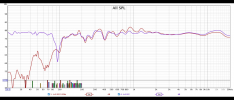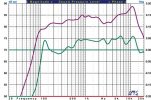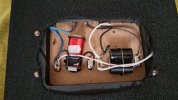It has a bass level +/- or flat but that's for taste not to filter.It doesn’t appear that preamp offers any bass management or a high pass filter. I believe you can buy external high pass filters that you can connect between your preamp and amp so a full range signal isn’t sent to the LRS.
-
WANTED: Happy members who like to discuss audio and other topics related to our interest. Desire to learn and share knowledge of science required. There are many reviews of audio hardware and expert members to help answer your questions. Click here to have your audio equipment measured for free!
You are using an out of date browser. It may not display this or other websites correctly.
You should upgrade or use an alternative browser.
You should upgrade or use an alternative browser.
Magnepan LRS Speaker Review
- Thread starter amirm
- Start date
What external filter do you suggest and at what frequencies is the cutoff?It doesn’t appear that preamp offers any bass management or a high pass filter. I believe you can buy external high pass filters that you can connect between your preamp and amp so a full range signal isn’t sent to the LRS.
Low pass = passes low frequencies, rejects (reduces, suppresses) high frequencies
High pass = passes high frequencies, suppresses low frequencies
High pass = passes high frequencies, suppresses low frequencies
Saturn94
Active Member
- Joined
- Feb 17, 2023
- Messages
- 115
- Likes
- 115
What external filter do you suggest and at what frequencies is the cutoff?
Unfortunately, I don’t have any experience with external crossovers/filters. Check out this thread. It might be helpful.

FMOD high pass filters?
Does anyone have first hand experience with these? https://www.hlabs.com/products/crossovers/index.htm Do they actually work as advertised? Any attenuation, distortion, noise issues? I am mainly interested in an inexpensive way to filter out bass at line level (RCA) going from preamp to my...
 www.audiosciencereview.com
www.audiosciencereview.com
A 90 Hz sound has a wavelength of 12.5 feet (3.8 m) so it's unlikely you can localize a 90 Hz tone from a subwoofer.I played with the low pass filter on the sub and 40Hz to 60Hz sounds thin but from 70Hz to 80Hz is great bass.
Above 90Hz the sub seems localized. Is this because the sub is also doing the higher frequency?
Assuming the crossover is typical 24 dB for a simple DSP application, there will be some midrange coming out of that sub, more and more at higher and higher crossover frequencies.
What's also likely is that the harmonics of 90 Hz are loud enough to be heard when this subwoofer is reproducing 90 Hz. Harmonics of 90 Hz can be localized by human hearing. 180 Hz not so much, but like the 4th harmonic - 360 Hz - or 5th harmonic - 450 Hz - have shorter wavelengths and also the ear is much more sensitive to sound at 450 Hz than it is at 90 Hz. The woofer cone in the sub may well have resonances up in this region or even higher - and these spurious sounds add to the ability to localize.
As @milosz said the crossover is not a brick wall dropping to zero at 90.0001 Hz; there is likely quite a bit of energy extending well past 100 Hz making the sub easier to localize.I played with the low pass filter on the sub and 40Hz to 60Hz sounds thin but from 70Hz to 80Hz is great bass.
Above 90Hz the sub seems localized. Is this because the sub is also doing the higher frequency?
Magnepan's LF corners can be a bit optimistic, especially since the room and speaker/listener placement heavily influence the response. That is probably why the bass sounds thin with a lower crossover; the LRS is not reproducing the deep bass.
IME/IMO - Don
Idk why Magnepan suggested a 50hz crossover because there is no bass in that region with a sub. That's their specs too.As @milosz said the crossover is not a brick wall dropping to zero at 90.0001 Hz; there is likely quite a bit of energy extending well past 100 Hz making the sub easier to localize.
Magnepan's LF corners can be a bit optimistic, especially since the room and speaker/listener placement heavily influence the response. That is probably why the bass sounds thin with a lower crossover; the LRS is not reproducing the deep bass.
IME/IMO - Don
50 Hz is their low-frequency corner spec, where the response is already rolling off, not necessarily the crossover point to a sub. I usually cross over an octave above that point (100 Hz) or so, at least half an octave, so 80 Hz is about right. A good trade between localizing the sub, reinforcing the bass, and taking a load off the panels.Idk why Magnepan suggested a 50hz crossover because there is no bass in that region with a sub. That's their specs too.
This is what I did with my Quad 2805 panels. Their measured response drops down steeply below 37 Hz, but an 80 Hz high pass filter gives them some more very welcome headroom.80 Hz is about right
Panels have limited excursion so to play louder you usually need larger panels. Theoretically stronger magnets (or stronger electric field for your ESLs) and stiffer diaphragm material with greater drive (power) would work, if you could get enough linear excursion, but in practice you just can't do it today (if ever). As a result, large bass signals cause high distortion (10's of percent at ~100 Hz and below) if those levels can be reached at all. Deep bass can require 10~1000+ times the power to be heard as loudly as midrange signals (equal loudness curves). Larger panels do a little better, but the realistic solution is a sub, which handles the bass and really reduces the distortion ("cleans up") the lower midrange and up (with a crossover to limit bass to the panel).This is what I did with my Quad 2805 panels. Their measured response drops down steeply below 37 Hz, but an 80 Hz high pass filter gives them some more very welcome headroom.
IME/IMO - Don
Do you like how they sound? Thats all that matters!Now I regret paying $2390 with tax for my 1.7i. The Kef R3 cost less and probably sound better.
This is exactly what I did - in fact thus far three of them, equalized by MSO.the realistic solution is a sub
Willem - I have the 2805 also - what slope & function (LR, Butterworth, etc) did you use?Their measured response drops down steeply below 37 Hz, but an 80 Hz high pass filter gives them some more very welcome headroom.
Playing with my Marchand XM44 Crossover and ,making a few 80hz HP/LP Frequency modules...
Sorry it took me a little while to dig up the data for the high pass filter: 80 Hz fourth order ( I think LR, but I am not sure). Mind you, this is using a passive inline filter, so I cannot change the properties. Matching had to be done with the low pass filter on the subs.Willem - I have the 2805 also - what slope & function (LR, Butterworth, etc) did you use?
Thus far, I have only used MSO to equalize the subs. The next step is to measure and equalize the electrostats as well, and import filter settings for those into my RME ADI-2. The bad news is, of course that those filters will equalize both outputs - the xlr ones used for the main speakers and the rca ones for the subs. I will have to see how that works out in practice.
Hellasärö
Member
- Joined
- Sep 9, 2022
- Messages
- 50
- Likes
- 93
I bought a pair of discontinued Magnepan mgmc1 (surround) speakers for testing. I crossed them over to a sub at 120hz and ran antimode X2 correction. Sounded and measured pretty good in a small well treated room in near field(1,5m). In my bigger room with a 3m listening distance they sounded horrible.
But will definitely experiment with EQ and DSP crossover in the small room. The midrange was the best I've heard in my small room. They measured better in-room than in the sound and vision test (2nd pic purple trace).
But will definitely experiment with EQ and DSP crossover in the small room. The midrange was the best I've heard in my small room. They measured better in-room than in the sound and vision test (2nd pic purple trace).
Attachments
JaCro
New Member
The buttons (or “tie-downs” in Magnepan parlance) that clamp the diaphragm at different locations, are placed there to both damp the fundamental resonance and create a redistributed group of resonances to passively, self-equalize, or enhance the output of the frequencies between the dipole baffle cutoff frequency and the lowest resonant frequency.I own a set of LRS+ maggies. Very pleased with them, but could somebody explain to me why the buttons on the left speaker differ from the right?
Any open baffle, dipole loudspeaker without this approach, and a driver with a “Q” of 0.707 or less, will have a first order (6dB/octave) high pass characteristic from the baffle cutoff frequency down to the fundamental resonant frequency, below which it will fall at 18dB/octave. Alternatively, most dipole film loudspeakers, such as an ESL or planar magnetic, will often have a singular high “Q” peak at the fundamental resonance with a droop in the amplitude response between the fundamental resonance and its baffle cutoff frequency.
While all the current Magneplanars use the distributed mode approach with symmetrical positions and button count on the left and right loudspeaker, the LRS and LRS+ are unique among the Magneplanars in that the system pairs use asymmetrical “tie-down” buttons, with (most examples) having 1-button on one of the loudspeakers, and 3-buttons on the other loudspeaker, creating 2-distributed modes on the first and 4-distributed modes on the second loudspeaker, or a total of six interleaved modes of different frequencies. This is effective at allowing the pair, when working together, to produce smoother and deeper bass than either single unit alone.
This makes achieving an accurate, meaningful measurement, more difficult, particularly if the tester doesn't know they are different or doesn’t understand how and why they are different from each other. Almost everyone that has publically disclosed measurements of the LRS’s appear to be unaware of this design element and have just measured one of the two speakers, providing a misleading result.
I hope this helps clarify the issue.
- James Croft
Similar threads
- Replies
- 134
- Views
- 21K
- Poll
- Replies
- 66
- Views
- 14K
- Replies
- 345
- Views
- 52K
- Replies
- 255
- Views
- 43K
- Poll
- Replies
- 333
- Views
- 57K




